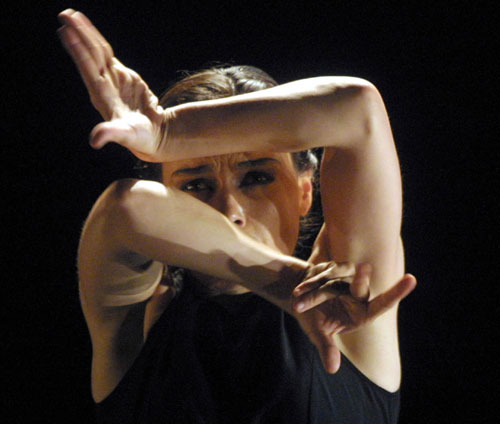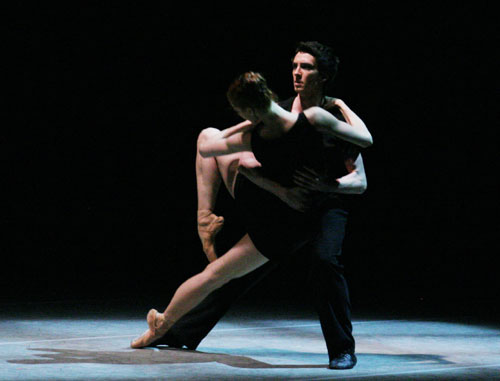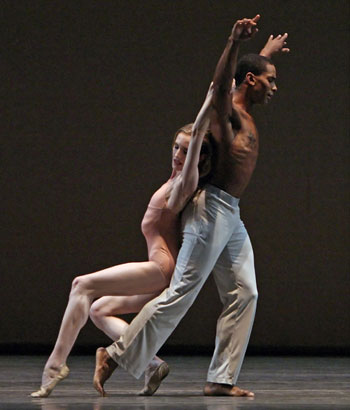This article originally appeared in Voice of Dance (http://www.voiceofdance.org) on October 8, 2007.
Fall for Dance Festival / New York City Center, NYC / September 26 – October 6, 2007

If you’re already a dance fan, you’re still welcome to come (after all, seasoned viewers really appreciate the bargain rate of $10 for any seat in New York’s huge, prestigious City Center). Bear in mind though, that the annual Fall for Dance Festival was not designed primarily for you. The brainchild of Arlene Shuler, it’s meant to seduce newbies, with its program of succinct takes from four or five different companies in its run of ten showings of six different programs. These programs are artfully contrived to encompass such a wide variety of dance genres–Twyla Tharp rubbing eloquent shoulders with the Kirov Ballet, postmodernists abutting practitioners of traditional Indian dance–that only a cultural clod could come away without discovering something to like. Now in its fourth year, with other cities wisely copycatting the idea (among them, Orange County Performing Artscenter, OCT 11-14), Fall for Dance has statistics to prove its significant contribution to increasing the audience for an art that could deliver ecstasy to far more people than it’s reaching.
Opening night’s first image was breathtaking: a bare-chested Michael Trusnovic–tall, strikingly pale and fair-haired, with pecs out of an ad for a gym–leapt forward on an imaginary diagonal route, one leg piercing the air before him, the other tucked up under him like a bird’s in flight, his gaze directed to a faraway, perhaps heavenly, horizon. Just seconds later, five buddies charged after him, full of the same muscular grace. A trio of women arrives eventually to soften and deepen their force, adding piquancy and tenderness, but this piece, Arden Court, remains a guys’ dance in which Paul Taylor emphasizes his conviction that the human animal morphs with ease between angel and gargoyle, beautiful and damned.
Have I mentioned the choreography’s musical savvy? Have I mentioned its intricate but always accessible structure, which has a divine logic to it, yet is full of surprises? No? Well, next time. Meanwhile, much praise is due to the dancers, who performed as if this were the occasion they’d be remembered by forever.

Ekaterina Kondaurova and Islom Baimuradov of the Kirov Ballet of the Mariinsky Theatre of St. Petersburg, Russia. Photo by Nina Alovert.
The middle of the program comprised a pair of small pieces: Middle Duet, by Alexei Ratmansky, who heads the Bolshoi Ballet, and a solo, Varnam, by the Indian dancer Shantala Shivalinggappa.
The Ratmansky, seen earlier in New York with City Ballet performers, has its partners practically welded to each other, while the woman puts the famous Russian-School placement and fluidity at the service of postmodern impulses. The man supports her antics with a submissive cooperation that evolves into understandable sullenness. Ratmansky’s choreography is both deft and witty concerning the manners and methods of ballet partnering. The Kirov Ballet duo that performed it, Ekaterina Kondaurova and Islom Baimuradov, were likewise deft and very charming.
In her pleated-skirt-over-trousers outfit of raspberry and gold, Shantala Shivalinggappa, choreographer and dancer for her offering, looked like a decorative figurine. She is a beautiful young woman who possesses, in the highest degree, the animated face, “speaking” eyes, and extraordinarily articulate fingers of her trade. When she works in place, telling her story in traditional mudras, her body takes on a wonderful sculptural quality, yet I found her too squarely tied to the beat of the onstage musicians. While her technical prowess was striking, she seemed–as if her imagination remains unkindled–to lack the quality we dare to call soul.
Of course it was a pleasure to see Twyla Tharp’s 1973 Deuce Coupe again and, you’d think, an inspired idea to cast it with Juilliard students, who combine crossover dance skills with the raw appeal of youth. Yet this production, staged by William Whitener, who was in the original version commissioned by the Joffrey Ballet, suggested that today’s youth, though technically glib, may not “get” the awkward passions of yesteryear’s young. What can the Beach Boys’ songs evoke in teens and twenty-somethings reared on rap?
The Juilliard dancers gave the piece a respectable rendition–one that at least conveyed the idea of it, if not its flesh and blood. Several of the male solos registered as tours de force, while Mary Ellen Beaudreau rightly aimed for the persistent calm of the girl in white who threads her way through the raucous, often stoned crowd, executing steps from the classical ballet lexicon in alphabetical order.
In the last three and a half decades, Tharp has gone on to create dances that are even more savvy than this one, but not one that’s as innocent, poignant, or so much fun. Like Jerome Robbins’s 1944 Fancy Free, Deuce Coupe comes from a time that will never return, and it’s good to be reminded of it.
For me, three of the five items on the October 4th program vied for Best in Show: the plangent duet from Christopher Wheeldon’s After the Rain, sensitively danced by Wendy Whelan and Craig Hall; Trisha Brown’s Spanish Dance, a line dance for five women that delivers this choreographer’s intelligence and wit in a nutshell; and Noche Flamenca, whose Soledad Barrio invariably takes you to the dark places of the soul and strips you of your protective blindfold.

Wendy Whelan and Craig Hall in Christopher Wheeldon’s After the Rain. Photo by Paul Kolnik.
Apart from the dancing itself, the most thrilling thing about the Fall for Dance performances was the audience, which had the vivacity of a bunch of high school students. The full houses applauded every item (even the abstruse ones) enthusiastically, cheered their favorites, and filled the pauses between numbers with animated chatter. It was a privilege to be in their midst. Their openness to joy–indeed, expectation of it–was contagious. I just hope, as do the Fall for Dance producers, that some of them will turn into veterans like the colleague I ran into in the lobby and asked, teasing, “So, are you going to fall for dance?” “I fell for dance a long time ago,” he replied, “and never got up.”
© VoiceofDance.com 2007



